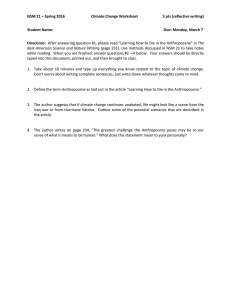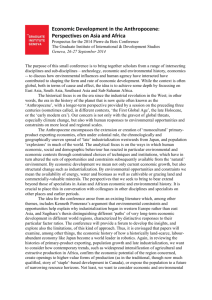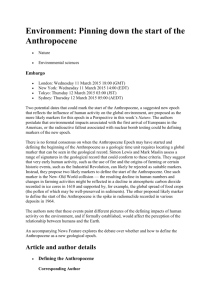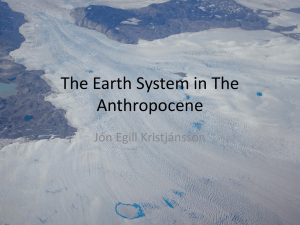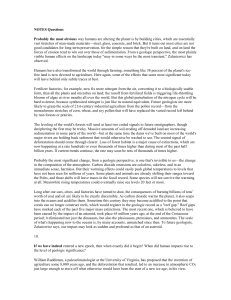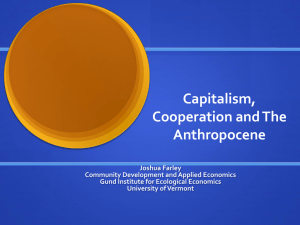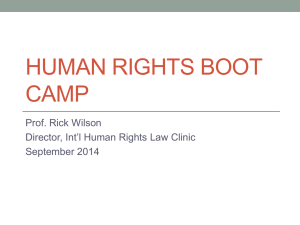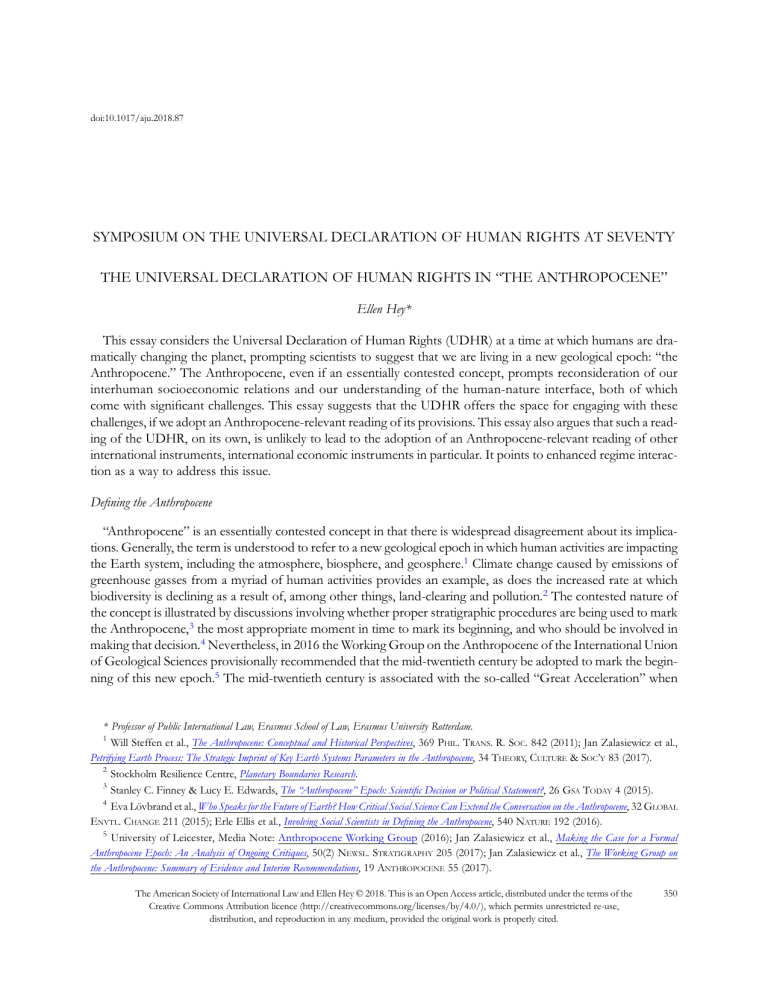
doi:10.1017/aju.2018.87 SYMPOSIUM ON THE UNIVERSAL DECLARATION OF HUMAN RIGHTS AT SEVENTY THE UNIVERSAL DECLARATION OF HUMAN RIGHTS IN “THE ANTHROPOCENE” Ellen Hey* This essay considers the Universal Declaration of Human Rights (UDHR) at a time at which humans are dramatically changing the planet, prompting scientists to suggest that we are living in a new geological epoch: “the Anthropocene.” The Anthropocene, even if an essentially contested concept, prompts reconsideration of our interhuman socioeconomic relations and our understanding of the human-nature interface, both of which come with significant challenges. This essay suggests that the UDHR offers the space for engaging with these challenges, if we adopt an Anthropocene-relevant reading of its provisions. This essay also argues that such a reading of the UDHR, on its own, is unlikely to lead to the adoption of an Anthropocene-relevant reading of other international instruments, international economic instruments in particular. It points to enhanced regime interaction as a way to address this issue. Defining the Anthropocene “Anthropocene” is an essentially contested concept in that there is widespread disagreement about its implications. Generally, the term is understood to refer to a new geological epoch in which human activities are impacting the Earth system, including the atmosphere, biosphere, and geosphere.1 Climate change caused by emissions of greenhouse gasses from a myriad of human activities provides an example, as does the increased rate at which biodiversity is declining as a result of, among other things, land-clearing and pollution.2 The contested nature of the concept is illustrated by discussions involving whether proper stratigraphic procedures are being used to mark the Anthropocene,3 the most appropriate moment in time to mark its beginning, and who should be involved in making that decision.4 Nevertheless, in 2016 the Working Group on the Anthropocene of the International Union of Geological Sciences provisionally recommended that the mid-twentieth century be adopted to mark the beginning of this new epoch.5 The mid-twentieth century is associated with the so-called “Great Acceleration” when * Professor of Public International Law, Erasmus School of Law, Erasmus University Rotterdam. 1 Will Steffen et al., The Anthropocene: Conceptual and Historical Perspectives, 369 PHIL. TRANS. R. SOC. 842 (2011); Jan Zalasiewicz et al., Petrifying Earth Process: The Strategic Imprint of Key Earth Systems Parameters in the Anthropocene, 34 THEORY, CULTURE & SOC’Y 83 (2017). 2 Stockholm Resilience Centre, Planetary Boundaries Research. 3 Stanley C. Finney & Lucy E. Edwards, The “Anthropocene” Epoch: Scientific Decision or Political Statement?, 26 GSA TODAY 4 (2015). 4 Eva Lövbrand et al., Who Speaks for the Future of Earth? How Critical Social Science Can Extend the Conversation on the Anthropocene, 32 GLOBAL ENVTL. CHANGE 211 (2015); Erle Ellis et al., Involving Social Scientists in Defining the Anthropocene, 540 NATURE 192 (2016). 5 University of Leicester, Media Note: Anthropocene Working Group (2016); Jan Zalasiewicz et al., Making the Case for a Formal Anthropocene Epoch: An Analysis of Ongoing Critiques, 50(2) NEWSL. STRATIGRAPHY 205 (2017); Jan Zalasiewicz et al., The Working Group on the Anthropocene: Summary of Evidence and Interim Recommendations, 19 ANTHROPOCENE 55 (2017). The American Society of International Law and Ellen Hey © 2018. This is an Open Access article, distributed under the terms of the Creative Commons Attribution licence (http://creativecommons.org/licenses/by/4.0/), which permits unrestricted re-use, distribution, and reproduction in any medium, provided the original work is properly cited. 350 2018 THE UNIVERSAL DECLARATION OF HUMAN RIGHTS IN “THE ANTHROPOCENE” 351 “the human enterprise switched gears,” prompted by a steep increase in worldwide economic activity.6 The Working Group suggests that these developments are global in nature and discernable in geological strata. Challenges Raised by the Anthropocene Regardless of debates surrounding decision-making about the advent of the Anthropocene, the notion that humans are affecting the Earth system requires us to rethink how we interact with each other and how we interact with nature (that is, the human-nature interface). Based on the literature on the topic, involving a host of disciplines, including the social sciences and international law,7 the Anthropocene brings to the fore at least three challenges that implicate the international legal system. First, not all past and current members of humanity have contributed equally to the advent of the Anthropocene. As Steffen et al. graphically illustrate, as of the mid-twentieth century human activities involving, for example, the use of fertilizer and the production of greenhouse gasses increased exponentially.8 However, these activities originated in Europe and North America; even if they have spread to the rest of the world, the poor in the past did not and today do not participate equally in them. Second, all present and future members of humanity will be impacted by changes in the Earth system, but they will not be impacted equally. As the Office of the United Nations High Commissioner for Human Rights highlighted in a 2009 report, “[t]he effects of climate change will be felt most acutely by those segments of the population who are already in vulnerable situations due to factors such as poverty, gender, age, minority status, and disability.”9 These first two concerns, then, suggest that we need to reconsider fundamentally how we as humans interrelate. As the Intergovernmental Panel on Climate Change pointed out in 2007, “For a development path to be sustainable over a long period, wealth, resources, and opportunity must be shared so that all citizens have access to minimum standards of security, human rights, and social benefits, such as food, health, education, shelter, and opportunity for self-development.”10 These socioeconomic implications raise formidable challenges in terms of the divide between the Global South and Global North and the role of international law in sustaining this divide, for example by supporting an international economic system that results in the marginalization of many.11 Third, the advent of the Anthropocene requires us to reconsider the human-nature interface. This poses a formidable intellectual challenge, as it requires us to reconceptualize what it means to be human. It no longer makes sense to consider nature as the backdrop against which human activities evolve. Instead, we need to internalize the idea that human activities impact the Earth system and that the reactions of the Earth system thereto impact humans across the globe, even if individuals will not be impacted equally. In other words, humans and nature form socialecological systems.12 6 Steffen et al., supra note 1, at 849. See, e.g., THE ANTHROPOCENE AND THE GLOBAL ENVIRONMENTAL CRISIS (Clive Hamilton et al. eds., 2015); ENVIRONMENTAL LAW AND GOVERNANCE FOR THE ANTHROPOCENE (Louis J. Kotzé ed., 2017). 8 Steffen et al., supra note 1. 9 UN Office of the High Commissioner on Human Rights, Report of the OHCHR on the Relationship Between Climate Change and Human Rights, U.N. Doc. A/HRC/10/61 (Jan. 15, 2009). 10 CLIMATE CHANGE 2007 MITIGATION, CONTRIBUTION OF WORKING GROUP III TO THE FOURTH ASSESSMENT REPORT OF THE INTERGOVERNMENTAL PANEL ON CLIMATE CHANGE 696 (Bert Metz et al. eds., 2007). 11 Anthony Anghie, International Financial Institutions, in THE POLITICS OF INTERNATIONAL LAW 217–37 (Christian Reus-Smit ed., 2004). 12 Carl Folke et al., Social-Ecological Resilience and Biosphere-Based Sustainability Science, 21(3) ECOLOGY & SOC’Y 41 (2016). 7 352 AJIL UNBOUND Vol. 112 The UDHR and the Anthropocene At the risk of stating the obvious, the advent of the Anthropocene compromises the realization of all rights protected by the UDHR, which, as such, should provide sufficient reason to develop an Anthropocene-relevant reading of the instrument. In light of the considerations outlined above, I suggest that the UDHR requires that policy-makers and scholars address the socioeconomic implications of the advent of the Anthropocene and that Article 27(1) enables us to adopt a new understanding of the human-nature interface. In addressing the socioeconomic implications of the advent of the Anthropocene, the following four features of the UDHR stand out. First, the UDHR does not prioritize among the rights it protects. As a result, social and economic rights stand on an equal footing with civil and political rights. Second, the UDHR does not privilege the state as the sole guardian of the rights it protects. Its preamble asserts that it provides “a common standard of achievement for all peoples and all nations” with “every individual and every organ of society” striving to attain respect for the rights and freedoms it protects. Furthermore, Article 30, besides “any State,” also requires “any … group or person” to refrain from interpreting the UDHR so as to justify activities or acts that would undermine the rights guaranteed therein. Third, Article 29(1) identifies “community” as an entity in which the rights protected in the UDHR are to be realized and to which everyone holds duties. Fourth, UDHR Article 28 stresses that the international order is implicated in the rights it protects. It provides that “[e]veryone is entitled to a social and international order in which the rights and freedoms set forth in this Declaration can be fully realized.”13 Together these four considerations suggest that the UDHR requires an Anthropocene-relevant reading when it comes to the Anthropocene’s socioeconomic implications. Given the nonprioritization of rights, the UDHR requires that we address the social and economic inequalities between the Global North and the Global South that the advent of the Anthropocene blatantly points to.14 The above-mentioned references to “every individual and every organ of society,” “group or person,” and “international order” in the UDHR are important because economic activity now spans the globe and involves states as well as international organizations and corporations. These actors construct and implement an international order, in particular an international economic order, that is not necessarily conducive to furthering human rights or the protection of the environment. As I have argued elsewhere, the international legal order, especially the economic order shaped by the World Trade Organization (WTO), the World Bank, the International Monetary Fund (IMF) and bilateral investment treaties, is implicated in this situation.15 The UDHR, however, suggests that the rights and freedoms it protects result in duties for all actors involved, including states, international organizations, and corporations. Individual international organizations and corporations surely qualify as an “organ of society” or “group” under the Preamble and Article 30 of the UDHR, while the individuals working within these institutions are covered by its Preamble and Articles 30 and 29. Note that international law is moving towards recognizing human rights duties of transnational corporate actors16 and that initiatives are being taken to develop the human rights obligations of international organizations. Lastly, the UDHR requires all dutyholders to consider the implications of “community” in Article 29(1). Given our interconnected socioeconomic relations across the globe, the term “community” should be understood as having global implications. As mentioned above, the UDHR does not tell us how to regard the human-nature interface. Yet nothing in the document prevents us from integrating, for example, the notion that humans and nature constitute 13 Universal Declaration of Human Rights art. 28, G.A. Res. 217A (III) (Dec. 8, 1948) (emphasis added). See supra notes 9–11 (and accompanying text). See also Philip Alston, The Populist Challenge to Human Rights, 9 J. HUM. RTS. PRAC. 1 (2017). 15 Ellen Hey, International Law and the Anthropocene, 5(10) ESIL REFLECTION (2016). 16 John Ruggie (Special Representative of the Secretary-General on the Issue of Human Rights and Transnational Corporations and Other Business Enterprises, Protect, Respect and Remedy: A Framework for Business and Human Rights, U.N. Doc. A/HRC/8/5 (Apr. 7, 2008). 14 2018 THE UNIVERSAL DECLARATION OF HUMAN RIGHTS IN “THE ANTHROPOCENE” 353 social-ecological systems into our interpretation of the UDHR. Moreover, UDHR Article 27(1) formulates the right of everyone “to share in scientific advancement and its benefits.” The awareness that humans are affecting the Earth system is the product of scientific research, as are the insights that the human-nature interface can be characterized as a social-ecological system and that dominant perceptions of the Anthropocene often come with a set of assumptions that accept and protect existing relations of power. The UDHR, then, can be read as imposing an obligation on all relevant actors to consider these scientific findings so that everyone, including members of future generations, can benefit therefrom. The ensuing discourse often will be discordant, given the essentially contested nature of the Anthropocene concept. Yet, given what is at stake, this is exactly the discourse we should engage in, with the UDHR offering us a “space” for engagement. The UDHR as a text, then, does not pose barriers to, but indeed can be understood to require, an Anthropocene-relevant reading of its provisions. Introducing such a reading of the UDHR would be a step in the right direction. Yet, due to the fragmented nature of the international legal system, the UDHR as well as other human rights instruments and environmental treaties will not necessarily impact international economic law. Below, I briefly consider how international human rights law and international environmental law have recently started to address the fragmented nature of international law through regime interaction.17 Regime Interaction in the Anthropocene Several scholars have suggested ways in which international law might address the advent of the Anthropocene. These include, but are not limited to, the development of a Grundnorm and the constitutionalization of international environmental law.18 Others have proposed the development of rights for nature, or Mother Earth.19 All these approaches have merit. Yet, simultaneously, given the fragmented nature of the international legal system, we should encourage regime interaction. To develop a Grundnorm, attain the constitutionalization of international environmental law, or develop a body of law that recognizes rights of nature, it is insufficient that these be recognized in international environmental law or in human rights law alone. Our focus should be on the international legal system as a whole, especially international economic law. Regime interaction is far from a panacea for all that is wrong with the international legal system. However, it may offer part of a way forward. An Anthropocene-relevant reading of the UDHR certainly would be a step in that process, though not a sufficient one. That reading of the UDHR would have to be further developed in terms of what it means for relevant actors, such as the WTO, the World Bank, and the IMF. Philip Alston has started to address the importance of social and economic rights for the activities that the World Bank and the IMF engage in.20 In addition, lessons might be learned from the successful cooperative efforts of NGOs, international institutions (including UN Special Rapporteur on Human Rights and the Environment, John Knox),21 and some states including a human rights approach in the 2015 Paris Agreement.22 17 See REGIME INTERACTION IN INTERNATIONAL LAW (Margaret Young ed., 2012). See Klaus Bosselmann, The Imperative of Ecological Integrity: Conceptualization of a Fundamental Legal Norm for a New ‘World System’ in the Anthropocene, in KOTZÉ, supra note 7, at 219; Louis Kotzé, Global Environmental Constitutionalism in the Anthropocene, in KOTZÉ, supra note 7, at 241. 19 RIGHTS OF MOTHER EARTH. 20 UN Special Rapporteur on Human Rights and the Environment, Annual Reports-Special Rapporteur on Extreme Poverty and Human Rights (2018). 21 UN Special Rapporteur on Human Rights and the Environment, Mapping Report, UN Doc. A/HRC/25/53 (Mar. 2014). 22 Daniel Magraw et al., Human Rights, Labour and the Paris Agreement on Climate Change, 46 ENVTL. POL’Y & L. 313 (2016). 18 354 AJIL UNBOUND Vol. 112 The Paris Agreement is the first climate change treaty that explicitly refers to human rights. It includes references to human rights in the Preamble. Further, Article 7, on adaptation, includes the concept of vulnerability, requiring parties to ensure that adaptation planning and action take into account the position of vulnerable groups. In addition, Article 8 incorporates the notions of “loss” and “damage,” thereby linking climate change responses to affectedness and vulnerability. The Paris Agreement, then, extends the distributional effects of climate change beyond the interstate level to the level of groups and communities in their local context.23 It thereby requires climate change policies to integrate the fact that not all humans will be impacted equally by the effects of climate change. Conclusion The UDHR remains a relevant instrument at a time when humans are affecting the Earth system. It does not prevent but rather can be read to require an Anthropocene-relevant reading. Undertaking such a reading and encouraging regime interaction might indeed foster the participatory and inclusive discourse that social scientists have suggested we should engage in to meaningfully address the advent of the Anthropocene.24 This discourse should not be limited to the level of international decision-making, but needs to encompass all levels of decisionmaking. After all, human rights, including those protected by the UDHR, are realized and violated by activities at the most local of levels, even if the advent of the Anthropocene highlights that an activity at one location on the globe may impact the enjoyment of rights elsewhere on the globe. Capturing the normative implications of this awareness is most challenging in view of the nature of the international (economic) order, in which socioeconomic rights have not been foregrounded equally with civil and political rights. Just as challenging is reconceptualizing our understanding of the human-nature interface as one of fundamental interconnectedness. However, the UDHR does not prevent us from embracing a social-ecological system reading of its provisions. Its Article 27(1) can be understood to require, at a minimum, engagement with such thinking. Given the essentially contested nature of the Anthropocene concept, the ensuing discourse inevitably will involve political contestation. The UDHR offers a space for engaging in this discourse. 23 See Ellen Hey & Federica Violi, The Hard Work of Regime Interaction: Climate Change and Human Rights, Report for the Royal Netherlands Society of International Law (KVNIR), in CLIMATE CHANGE: OPTIONS AND DUTIES UNDER INTERNATIONAL LAW, PREADVIEZEN NO. 145 at 1 (2018). 24 See sources listed supra note 4.
